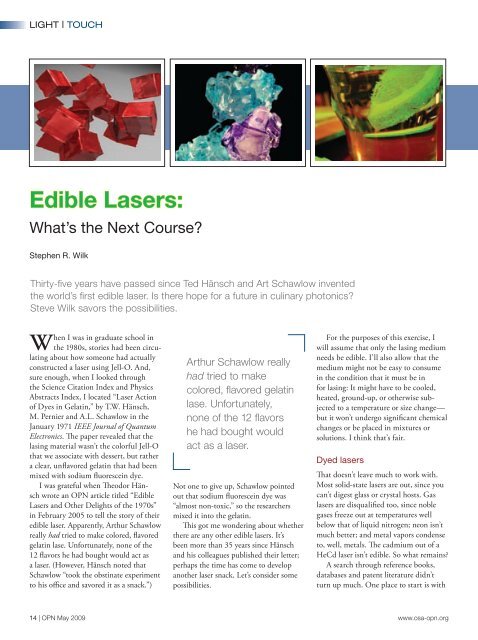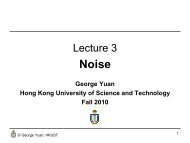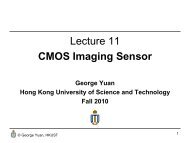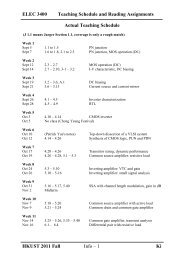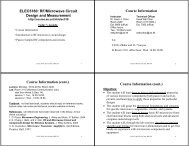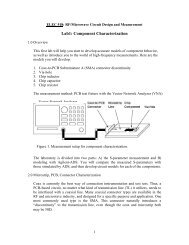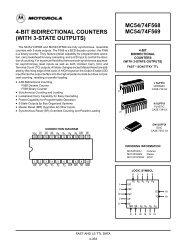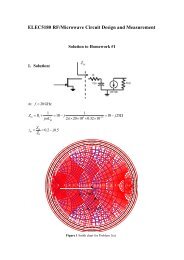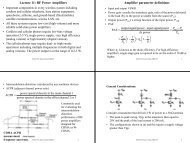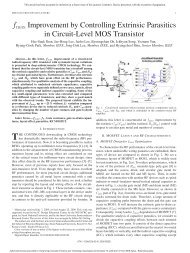You also want an ePaper? Increase the reach of your titles
YUMPU automatically turns print PDFs into web optimized ePapers that Google loves.
LIGHT | TOUCH<br />
<strong>Edible</strong> Lasers:<br />
What’s <strong>the</strong> Next Course?<br />
Stephen R. Wilk<br />
Thirty-five years have passed since Ted Hänsch and Art Schawlow invented<br />
<strong>the</strong> world’s first edible laser. Is <strong>the</strong>re hope for a future in culinary photonics?<br />
Steve Wilk savors <strong>the</strong> possibilities.<br />
When I was in graduate school in<br />
<strong>the</strong> 1980s, stories had been circulating<br />
about how someone had actually<br />
constructed a laser using Jell-O. And,<br />
sure enough, when I looked through<br />
<strong>the</strong> Science Citation Index and Physics<br />
Abstracts Index, I located “Laser Action<br />
of Dyes in Gelatin,” by T.W. Hänsch,<br />
M. Pernier and A.L. Schawlow in <strong>the</strong><br />
January 1971 IEEE Journal of Quantum<br />
Electronics. The paper revealed that <strong>the</strong><br />
lasing material wasn’t <strong>the</strong> colorful Jell-O<br />
that we associate with dessert, but ra<strong>the</strong>r<br />
a clear, unflavored gelatin that had been<br />
mixed with sodium fluorescein dye.<br />
I was grateful when Theodor Hänsch<br />
wrote an OPN article titled “<strong>Edible</strong><br />
Lasers and O<strong>the</strong>r Delights of <strong>the</strong> 1970s”<br />
in February 2005 to tell <strong>the</strong> story of <strong>the</strong>ir<br />
edible laser. Apparently, Arthur Schawlow<br />
really had tried to make colored, flavored<br />
gelatin lase. Unfortunately, none of <strong>the</strong><br />
12 flavors he had bought would act as<br />
a laser. (However, Hänsch noted that<br />
Schawlow “took <strong>the</strong> obstinate experiment<br />
to his office and savored it as a snack.”)<br />
Arthur Schawlow really<br />
had tried to make<br />
colored, flavored gelatin<br />
lase. Unfortunately,<br />
none of <strong>the</strong> 12 flavors<br />
he had bought would<br />
act as a laser.<br />
Not one to give up, Schawlow pointed<br />
out that sodium fluorescein dye was<br />
“almost non-toxic,” so <strong>the</strong> researchers<br />
mixed it into <strong>the</strong> gelatin.<br />
This got me wondering about whe<strong>the</strong>r<br />
<strong>the</strong>re are any o<strong>the</strong>r edible <strong>lasers</strong>. It’s<br />
been more than 35 years since Hänsch<br />
and his colleagues published <strong>the</strong>ir letter;<br />
perhaps <strong>the</strong> time has come to develop<br />
ano<strong>the</strong>r laser snack. Let’s consider some<br />
possibilities.<br />
For <strong>the</strong> purposes of this exercise, I<br />
will assume that only <strong>the</strong> lasing medium<br />
needs be edible. I’ll also allow that <strong>the</strong><br />
medium might not be easy to consume<br />
in <strong>the</strong> condition that it must be in<br />
for lasing: It might have to be cooled,<br />
heated, ground-up, or o<strong>the</strong>rwise subjected<br />
to a temperature or size change—<br />
but it won’t undergo significant chemical<br />
changes or be placed in mixtures or<br />
solutions. I think that’s fair.<br />
Dyed <strong>lasers</strong><br />
That doesn’t leave much to work with.<br />
Most solid-state <strong>lasers</strong> are out, since you<br />
can’t digest glass or crystal hosts. Gas<br />
<strong>lasers</strong> are disqualified too, since noble<br />
gases freeze out at temperatures well<br />
below that of liquid nitrogen; neon isn’t<br />
much better; and metal vapors condense<br />
to, well, metals. The cadmium out of a<br />
HeCd laser isn’t edible. So what remains?<br />
A search through reference books,<br />
databases and patent literature didn’t<br />
turn up much. One place to start is with<br />
14 | OPN May 2009<br />
www.osa-opn.org
laser dyes. As Schawlow noted, sodium<br />
fluorescein isn’t very toxic. Nei<strong>the</strong>r, for<br />
that matter, are coumarin dyes. One<br />
expert I spoke with noted that some<br />
dyes, such as <strong>the</strong> sulforhodamines, exit<br />
<strong>the</strong> body quickly and would arguably be<br />
a better choice if you were determined<br />
to drink your dye. (I want to emphasize<br />
that I am NOT advocating this. I<br />
strongly insist that you do not try this<br />
at home.)<br />
All of <strong>the</strong>se dyes are soluble and<br />
lasable in ethanol, so you could, in principle,<br />
drink <strong>the</strong>m. In fact, a droplet of<br />
alcohol containing <strong>the</strong> dye would itself<br />
constitute a complete laser, as Hänsch<br />
showed. With <strong>the</strong> light totally internally<br />
reflecting from <strong>the</strong> interior droplet<br />
surfaces, <strong>the</strong> entire laser is edible. The<br />
actual toxicity of <strong>the</strong>se dyes has not been<br />
fully established, however. Certainly<br />
most laser dyes are toxic, especially <strong>the</strong><br />
cyanide-based ones. Also, <strong>the</strong>se examples<br />
of laser dyes in gelatin or ethanol<br />
don’t stray far from <strong>the</strong> work of Hänsch<br />
and Schawlow.<br />
Salty <strong>lasers</strong><br />
One new possibility is a color-center<br />
laser, which uses point defects in crystal<br />
lattices as broadband, tunable laser sources.<br />
Granted, many of <strong>the</strong>se crystals are<br />
minimally soluble, indigestible crystals<br />
such as lithium fluoride or even diamond.<br />
But most of <strong>the</strong> lasing defects are in<br />
potassium chloride or sodium chloride.<br />
Two of <strong>the</strong> crystals used by <strong>the</strong> only<br />
commercial color center laser were<br />
potassium chloride, which is certainly<br />
edible when ground up or licked; in<br />
fact, it’s used as a salt substitute. Most<br />
of <strong>the</strong> color centers involve impurities<br />
introduced into <strong>the</strong> crystals, but <strong>the</strong>se<br />
are at low concentrations—typically<br />
about 1 percent—and most are benign,<br />
being o<strong>the</strong>r alkali metal ions. However,<br />
both KCl and NaCl crystals are host to<br />
defects that don’t involve impurities.<br />
Besides defect <strong>lasers</strong>, <strong>the</strong>re are also<br />
laser materials in which <strong>the</strong> salt crystal<br />
acts as a host medium for lasing molecular<br />
ions. My own work on superoxide<br />
ions in salt crystals is an example.<br />
“One-Drop-Only” dye laser, a precursor of<br />
<strong>the</strong> edible laser.<br />
One new possibility is<br />
a color-center laser,<br />
which uses point<br />
defects in crystal<br />
lattices as broad-band,<br />
tunable laser sources.<br />
Unfortunately, <strong>the</strong>re aren’t too many<br />
o<strong>the</strong>r edible crystals. However, <strong>the</strong>re are<br />
alkali halide crystals, and o<strong>the</strong>r color<br />
centers in some of those (such as rubidium<br />
chloride or potassium bromide).<br />
No one, to my knowledge, has reported<br />
laser properties in defects or impurity<br />
centers in, say, rock candy, or crystallized<br />
proteins. Perhaps this column will spur<br />
someone to take up <strong>the</strong> challenge.<br />
Liquid <strong>lasers</strong><br />
What about liquids? Our choices here<br />
are limited as well. Water and ethanol<br />
are potable, but most o<strong>the</strong>r fluids,<br />
including organic liquids, are not. You<br />
can drink small amounts of glycerine,<br />
but I haven’t been able to lase <strong>the</strong>m,<br />
even with <strong>the</strong> inclusion of dyes. Aside<br />
from organic compounds and <strong>the</strong>ir<br />
perhalogenated analogs, and silicones,<br />
most substances that are liquid at room<br />
temperature are ei<strong>the</strong>r highly toxic or<br />
highly reactive in <strong>the</strong> presence of organic<br />
liquids and water.<br />
However, water and alcohol in vapor<br />
form meet my guidelines: Although you<br />
can’t consume <strong>the</strong>m as a vapor, you can<br />
condense and drink <strong>the</strong>m without making<br />
any o<strong>the</strong>r alteration. There are about<br />
two dozen lines on which water vapor<br />
will lase continuously between 2 and<br />
350 µm. And ethyl alcohol has been<br />
found to lase at 396 µm. There must be<br />
o<strong>the</strong>rs. Methyl alcohol has more than<br />
100 lasing lines in <strong>the</strong> infrared. Perhaps<br />
this is a fruitful area for future research.<br />
And what about <strong>the</strong> fabled gin-and<br />
tonic laser, ano<strong>the</strong>r rumor I’d heard during<br />
my graduate school days? According<br />
to D.A. Jennings, K.M. Evenson and<br />
J.J. Jimenez, all working at <strong>the</strong> NIST<br />
laboratory in Boulder, Colo., U.S.A.,<br />
in 1975, <strong>the</strong> “…ethyl alcohol line lased<br />
very well on vodka, gin and rum, but it<br />
lased on only one line and ra<strong>the</strong>r weakly<br />
compared with methyl alcohol. It is quite<br />
obvious that <strong>the</strong>re are better uses of ethyl<br />
alcohol.” I’ll drink to that. t<br />
Stephen Wilk (swilk@comcast.net) is an optical<br />
engineer based in Saugus, Mass., U.S.A.<br />
[ References and Resources ]<br />
>> W.S. Benedict et al. “The water vapor<br />
laser,” IEEE J. Quantum Electron. 5(2),<br />
108-24 (1969).<br />
>> T.W. Hänsch et al. “Laser action of dyes<br />
in gelatin,” IEEE J. Quantum Electron. 7,<br />
45-6 (Jan. 1971).<br />
>> J.G. Kepros et al. “Experimental evidence<br />
of an X-ray laser,” Proc. Natl. Acad. Sci.<br />
USA, 69(7), 1744-5 (1972).<br />
>> D.A. Jennings et al. “New CO 2<br />
pumped<br />
CW far-infrared laser lines,” IEEE J.<br />
Quantum Electron. 11, 637 (1975).<br />
>> A. Kues and G.A. Lutty. “Dyes can be<br />
deadly,” Laser Focus 11(5), 59–61 (May<br />
1975).<br />
>> S.R. Wilk et al. “Laser characteristics<br />
of KNL:O 2<br />
,” Opt. Comm. 47(6), 404-6<br />
(1983).<br />
>> J.F. Pinto et al. “Stable color-center<br />
laser in K-doped NaCl tunable from 1.42<br />
to 1.76 µm,” Opt. Letters 10(8), 384-6<br />
(1985).<br />
>> T.W. Hansch et al. “<strong>Edible</strong> <strong>lasers</strong> and<br />
o<strong>the</strong>r delights of <strong>the</strong> 1970s,” Opt. Photon.<br />
News 16(2), 14-6 (2005).<br />
OPN May 2009 | 15


